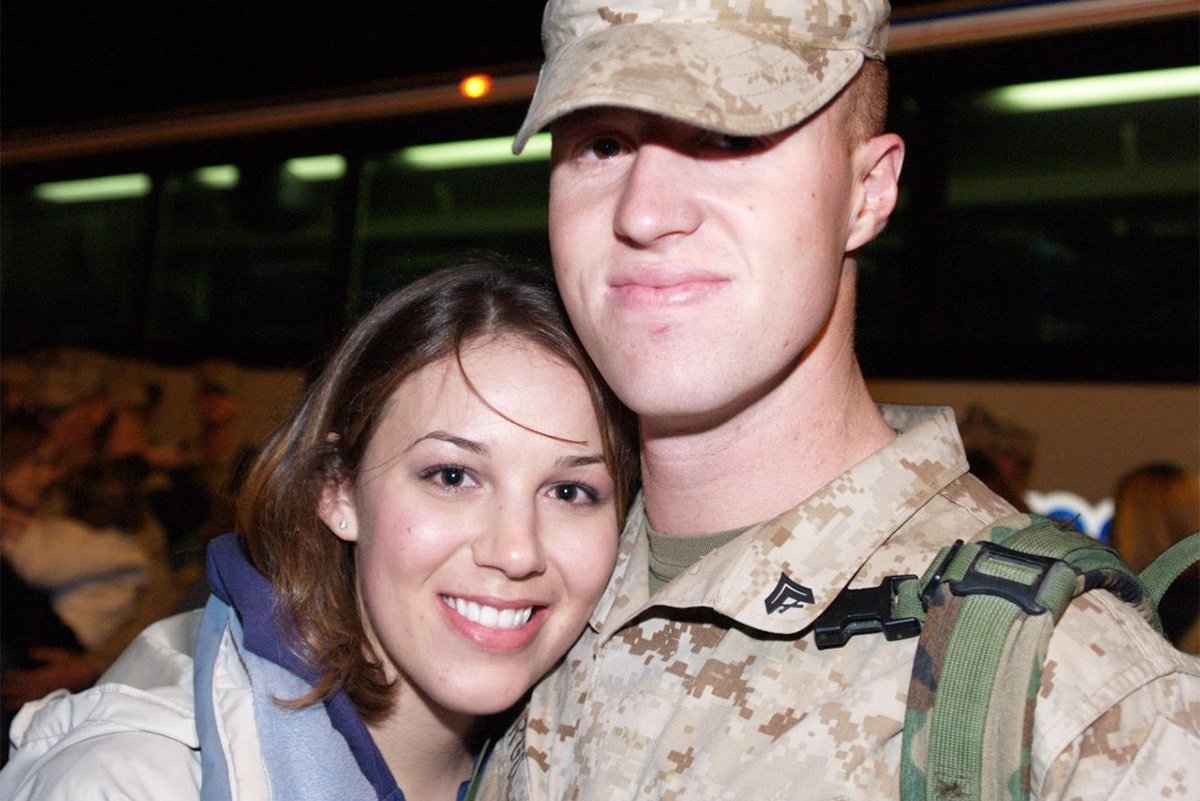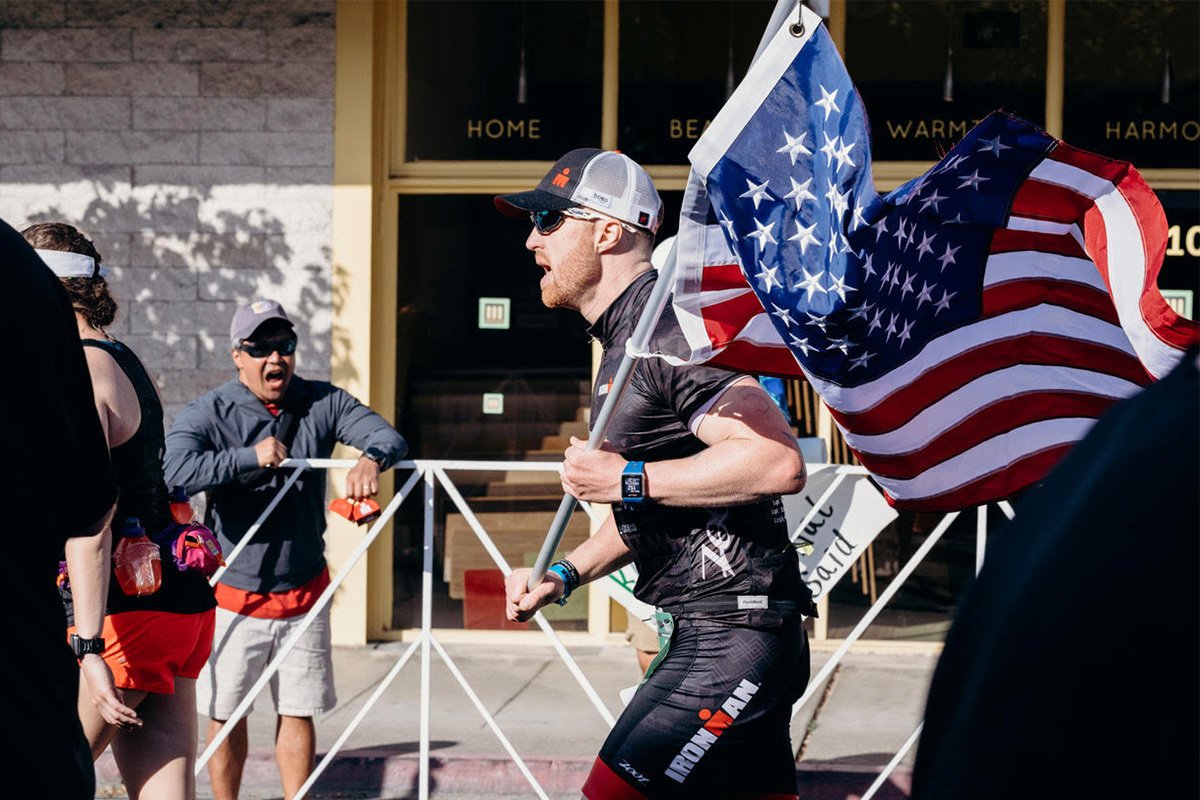Shot in the Neck Offers PTSD Relief to Some Veterans, Treatment Approved for New Study

Mike Ergo suffered from the effects of post-traumatic stress disorder for years after returning from Iraq. Now, he says he’s found relief through a PTSD treatment known as stellate ganglion block. Photos courtesy of Mike Ergo.
As bullets flew past his neck so close that their heat singed his skin, Michael Ergo felt an intense sense of peace wash over him: He was going to die, but at least he would go down fighting, surrounded by his teammates. He suddenly felt aware of every cell in his body, then felt his perception expanding, like he was part of the house in Fallujah, then the city itself, and finally the universe.
In the years since, the closest he’s ever come to recapturing that timeless, worry-free feeling was being hooked up to an opiate drip in a hospital.
But that day in Fallujah, the sensation didn’t last. After what felt like an eternity — but was probably only a millisecond — Ergo snapped back into the present and kicked down a door.
For years to come, every time he considered that out-of-body moment, he would be shattered by the memory of what came next: the flash of a grenade. An insurgent’s death rattle. And the chunks of flesh splattered across Ergo’s own uninjured face.
From day one in the Marine Corps, Ergo had been conditioned to respond to commands like “Ready, move” by yelling, “Kill!” For years, he trained to kill someone, and now he had.

“The ecstasy and bloodlust I was feeling was pretty overpowering,” Ergo said. “But there was a lot of trauma there too. It was a near-death experience. I felt trapped and was just trying to comprehend this room with body parts everywhere that didn’t fit together anymore.”
Ergo struggled with post-traumatic stress for more than a decade following that deployment to Iraq in 2005 with 1st Battalion, 8th Marines. But he says he finally found peace last year through a treatment known as stellate ganglion block, or SGB. While SGB has been used to treat pain for about a century, its use for treating post-traumatic stress is still relatively novel. In SGB, a doctor injects an anesthetic into a bundle of nerves in a patient’s neck to disrupt the “fight or flight” response activated by the sympathetic nervous system. Researchers hope a newly approved study at New York University will increase understanding of the treatment and help more patients like Ergo find relief.
After the violent mission, the things Ergo saw outside the wire haunted him back on base. He couldn’t sleep, feeling on edge, like another fight was about to go down. In the dimly lit barracks, his mind played tricks on him. He thought he saw an insurgent peering into the room from behind the bathroom door. He kicked it open, but there was no one there.
When he returned home to California, cannabis and alcohol became his closest friends. But he still suffered from intense bouts of paranoia. Walking around his community college campus, he felt convinced there were snipers on the rooftops. Driving to school some days, his palms would go slick with sweat on the steering wheel. He was convinced he was about to die. Sometimes he would push on and drive the rest of the way to school. Other times, he would turn around and numb out with weed and booze at home.

In 2012, his wife had finally had enough. She told him to get clean or get out.
“I could never feel calm unless I was high,” Ergo told Coffee or Die Magazine. “I hesitated. I thought my life was going to be just miserable and I’d have all these panic attacks again.”
But he quit the drugs and drinking and went full throttle into fitness as a means to recovery; running, CrossFit, yoga, eating clean, daily meditation, and swimming, which soon became his favorite refuge. It had a rhythm. Three strokes, breathe on the right. Three more strokes, breathe on the left.
But one day in the pool, he froze midstroke. His hands fumbled for the lane divider to hold on to as he struggled to breathe.
“I didn’t know if I was having a heart attack or if I was dying or what, but it turned out it was a panic attack,” Ergo said. “I was doing everything, and I was still having panic attacks.”

Sixteen years after the horrors of Fallujah, he finally knew changing his lifestyle wouldn’t be enough. Then, Ergo received a touch of luck when his acquaintance Dr. Shauna Springer called him.
They had crossed paths through Ergo’s work at a Bay Area Department of Veterans Affairs veteran’s center, and now Springer was working for the Stella Center, which offers SGB treatment at dozens of offices around the country. She wanted to know whether Ergo was interested in trying SGB therapy.
He’d never heard of it, but after the pool, he was ready to try.
On the day of his appointment, Ergo drove about an hour to the Stella Center in San Jose. He opted for twilight anesthesia — which makes a patient groggy, but conscious — in case he didn’t enjoy the feeling of the needle.
After about half an hour of observation, Ergo was free to leave. He said he noticed the effects right away. He likens the feeling to the immediate aftermath of a good open-water swim in the Pacific Ocean — he felt calm and refreshed.

He half expected that feeling to go away, but a year later, he says he hasn’t experienced a single panic attack since.
“It wasn’t like I was totally blasé,” he said. “I’ll feel the appropriate amount of fear when a situation isn’t right or I need to act immediately. I just don’t sweat the things I used to sweat.”
The Study
Post-traumatic stress disorder has been identified as one of the most pervasive “invisible” wounds of war for service members who deployed to Iraq and Afghanistan. While the illness is often associated with veterans, the Stella Center also offers treatment for civilians of all walks of life, affirming that PTSD can affect anyone.
SGB is currently only approved by the FDA to treat pain, but doctors are allowed to administer SGB off-label for other conditions, including PTSD. The procedure is occasionally used to treat post-traumatic stress disorder symptoms at military facilities, including Womack Army Medical Center, Tripler Army Medical Center, and Landstuhl Regional Medical Center. Medal of Honor recipient Dakota Meyer has openly discussed his experience with PTSD and said SGB treatment “changed my life.”
A clinical trial was greenlighted on May 26 that researchers hope will help destigmatize PTSD as an illness and add to the public’s understanding of SGB as a potential treatment.
Researchers anticipate being able to demonstrate that post-traumatic stress disorder can actually be seen on a patient’s brain scan, according to the Stella Center’s chief strategy officer Michael Gershenzon. The Stella Center’s top medical officer worked with the neurology team at NYU to design the study.
Researchers suspect pre-SGB brain scans will show a participant’s amygdala, a core part of the body’s fear center, “lit up like a candle,” Gershenzon told Coffee or Die.
“One goal is to just show and destigmatize PTSD and prove beyond a shadow of a doubt that it is a biological phenomenon,” Gershenzon said.
The study aims to enroll about 127 participants with post-traumatic stress disorder who will randomly be separated into two groups; a placebo group and a treatment group. Both groups will undergo a functional magnetic resonance imaging (fMRI) of their brain. Then the treatment group will receive a stellate ganglion block just like Ergo did, while the placebo group gets a saline injection instead.

Right now, medical officials believe injecting an anesthetic into a bundle of nerves in the neck can disrupt some of the worst trauma symptoms, such as surges of anxiety, hypervigilance, irritability, and interrupted sleep.
About a month after the procedure, both study groups will undergo a clinical assessment and a second fMRI of their brains. After treatment, the researchers anticipate seeing less activity in the amygdala.
It will take nearly a year for early results to start coming out of the new study.
Of 387 Stella Center patients who received a single SGB treatment between December 2016 and February 2020, more than 80% reported an average 28.9-point decrease in their PTSD checklists (PCL) — a significant reduction — according to a study published this year in the journal Pain Physician. A PCL score reflects a self-report survey, and according to the Department of Veterans Affairs, research suggests a 10-point decrease in a patient’s PCL score is clinically meaningful.
But the completion of the new clinical study could help transform SGB therapy into a front-line treatment, Gershenzon said, one that patients don’t have to wait years to obtain or pay for out of pocket. Currently, the injections cost around $1,000 to $3,000.

While both Gershenzon and Ergo hope the study will ultimately make it easier for those suffering from post-traumatic stress disorder to try SGB, they emphasized that the treatment shouldn’t be seen as a silver bullet or one-and-done deal.
“Mental health support, familial support, community support are really important around any intervention, including SGB,” Gershenzon said.
“This is the closest thing we have to a magic pill,” Ergo said. “But you have to do the supportive therapy with it afterwards to make the changes in your life.”
Read Next:

Hannah Ray Lambert is a former staff writer for Coffee or Die who previously covered everything from murder trials to high school trap shooting teams. She spent several months getting tear gassed during the 2020-2021 civil unrest in Portland, Oregon. When she’s not working, Hannah enjoys hiking, reading, and talking about authors and books on her podcast Between Lewis and Lovecraft.
BRCC and Bad Moon Print Press team up for an exclusive, limited-edition T-shirt design!
BRCC partners with Team Room Design for an exclusive T-shirt release!
Thirty Seconds Out has partnered with BRCC for an exclusive shirt design invoking the God of Winter.
Lucas O'Hara of Grizzly Forge has teamed up with BRCC for a badass, exclusive Shirt Club T-shirt design featuring his most popular knife and tiomahawk.
Coffee or Die sits down with one of the graphic designers behind Black Rifle Coffee's signature look and vibe.
Biden will award the Medal of Honor to a Vietnam War Army helicopter pilot who risked his life to save a reconnaissance team from almost certain death.
Ever wonder how much Jack Mandaville would f*ck sh*t up if he went back in time? The American Revolution didn't even see him coming.
A nearly 200-year-old West Point time capsule that at first appeared to yield little more than dust contains hidden treasure, the US Military Academy said.












